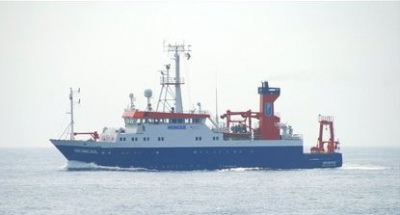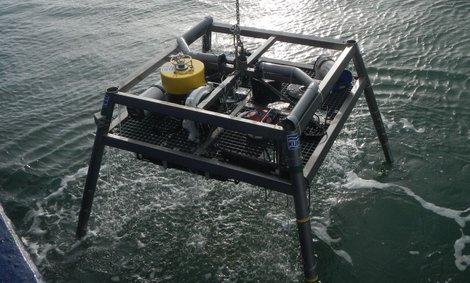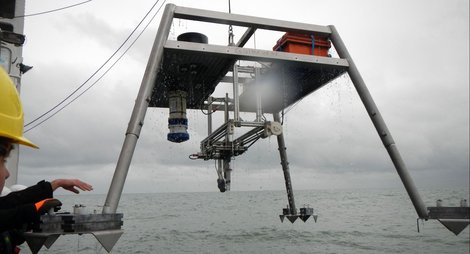Die Inhalte dieser Seite sind leider nicht auf Deutsch verfügbar.
Seitenpfad:
- Coastal Dynamics
- Expeditions
- HE 417
HE 417
HE 417
Vessel: RV Heincke
Dates: 10.3. (Bremerhaven) to 25.3.2014 (Bremerhaven)
Area: German Bight
Involved Projects: NOAH / MARUM SD1 CCP5 / COSYNA
PI: Christian Winter (MARUM)
Participants: Arne Schwab (MARUM), Eberhard Kopiske (MARUM), Markus Bennighoff (Uni HB), Mareike Büld (Uni HH), Moritz Holtappels (MARUM, MPI), Sören Ahmerkamp (MPI), David Probandt (MPI), Robin Hinz (Senckenberg), Ulrike Schückel (Senckenberg), Roi Martinez (AWI), Ingrid Dohrmann (AWI), Markus Benninghoff (Uni HB)
The Southern German Bight features a high spatial variability of sea floor sedimentology, geomorphological structures, biogeochemical characteristics and benthic habitats. This spatial diversity is controlled by environmental boundary conditions that act on a broad range of spatiotemporal scales. A process based understanding of these systems requires knowledge on the (small scale) characteristics of the seafloor, and the effects of different (short term) forcing mechanisms on seafloor morphology and sedimentology, their interaction with microbial processes, and the abundance of benthic species.
The main objectives of the cruise HE417 were the measurements of biogeochemical and physical processes at the seafloor to assess the effect of different forcing conditions (waves, currents) on exemplary sea bed environments (fine sand, coarse sand, bed forms). The cruise had a methodological focus on autonomous observatories: Shallow water sea floor landers with various instruments that were deployed on the sea floor. Twenty deployments of different lander systems were carried out for periods ranging from a few hours to some days. The bathymetry and sea floor structure of the chosen domains were mapped with the ship based multibeam echo sounder EM710 (MBES) and parametric echo sounder (SES) and seafloor samples were taken for on board and later laboratory analyses. These include core incubations and different geobiochemical and sedimentological analyses.
On board scientists and research interests cover the disciplines of marine microbiology, biology, geosciences. People from different German Marine research institutions (MARUM, AWI, MPI, SNG) and Universities (U Bremen, U Hamburg) cooperated in this cruise. The cruise had been mainly dedicated to three projects: 1. BMBF NOAH (Assessment of representative sea floor habitats of the German EEZ), 2. MARUM SD1 (Bridging scales), 3. MARUM-CCP5 (Organic-matter remineralization and nutrient turnover in permeable sandy sediments), and 4. COSYNA (Coastal Observing System for Northern and Arctic Seas). Additionally the cruise served other PhD, MSc, BSc projects of students at U Bremen and Hamburg.
Dates: 10.3. (Bremerhaven) to 25.3.2014 (Bremerhaven)
Area: German Bight
Involved Projects: NOAH / MARUM SD1 CCP5 / COSYNA
PI: Christian Winter (MARUM)
Participants: Arne Schwab (MARUM), Eberhard Kopiske (MARUM), Markus Bennighoff (Uni HB), Mareike Büld (Uni HH), Moritz Holtappels (MARUM, MPI), Sören Ahmerkamp (MPI), David Probandt (MPI), Robin Hinz (Senckenberg), Ulrike Schückel (Senckenberg), Roi Martinez (AWI), Ingrid Dohrmann (AWI), Markus Benninghoff (Uni HB)
The Southern German Bight features a high spatial variability of sea floor sedimentology, geomorphological structures, biogeochemical characteristics and benthic habitats. This spatial diversity is controlled by environmental boundary conditions that act on a broad range of spatiotemporal scales. A process based understanding of these systems requires knowledge on the (small scale) characteristics of the seafloor, and the effects of different (short term) forcing mechanisms on seafloor morphology and sedimentology, their interaction with microbial processes, and the abundance of benthic species.
The main objectives of the cruise HE417 were the measurements of biogeochemical and physical processes at the seafloor to assess the effect of different forcing conditions (waves, currents) on exemplary sea bed environments (fine sand, coarse sand, bed forms). The cruise had a methodological focus on autonomous observatories: Shallow water sea floor landers with various instruments that were deployed on the sea floor. Twenty deployments of different lander systems were carried out for periods ranging from a few hours to some days. The bathymetry and sea floor structure of the chosen domains were mapped with the ship based multibeam echo sounder EM710 (MBES) and parametric echo sounder (SES) and seafloor samples were taken for on board and later laboratory analyses. These include core incubations and different geobiochemical and sedimentological analyses.
On board scientists and research interests cover the disciplines of marine microbiology, biology, geosciences. People from different German Marine research institutions (MARUM, AWI, MPI, SNG) and Universities (U Bremen, U Hamburg) cooperated in this cruise. The cruise had been mainly dedicated to three projects: 1. BMBF NOAH (Assessment of representative sea floor habitats of the German EEZ), 2. MARUM SD1 (Bridging scales), 3. MARUM-CCP5 (Organic-matter remineralization and nutrient turnover in permeable sandy sediments), and 4. COSYNA (Coastal Observing System for Northern and Arctic Seas). Additionally the cruise served other PhD, MSc, BSc projects of students at U Bremen and Hamburg.





